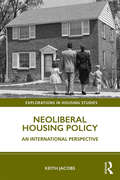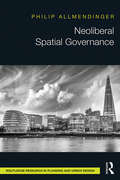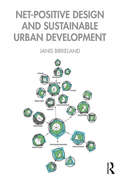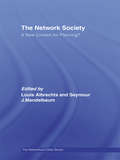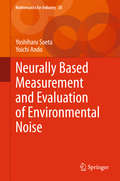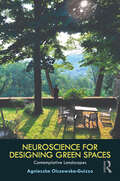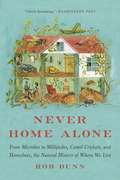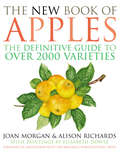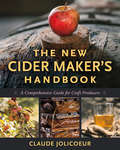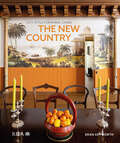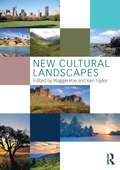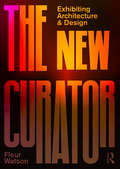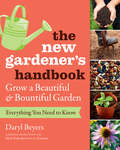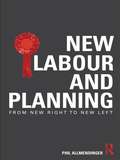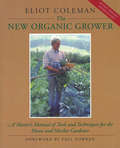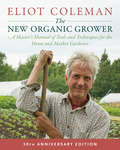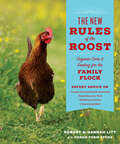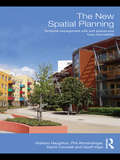- Table View
- List View
Neoliberal Housing Policy: An International Perspective (Explorations in Housing Studies)
by Keith JacobsNeoliberal Housing Policy considers some of the most significant housing issues facing the West today, including the increasing commodification of housing; the political economy surrounding homeownership; the role of public housing; the problem of homelessness; the ways that housing accentuates social and economic inequality; and how suburban housing has transformed city life. The empirical focus of the book draws mainly from the US, UK and Australia, with examples to illustrate some of the most important features and trajectories of late capitalism, including the commodification of welfare provision and financialisation, while the examples from other nations serve to highlight the influence of housing policy on more regional- and place-specific processes. The book shows that developments in housing provision are being shaped by global financial markets and the circuits of capital that transcend the borders of nation states. Whilst considerable differences within nation states exist, many government interventions to improve housing often fall short. Adopting a structuralist approach, the book provides a critical account of the way housing policy accentuates social and economic inequalities and identifies some of the significant convergences in policy across nations states, ultimately offering an explanation as to why so many ‘inequalities’ endure. It will be useful for anyone in professional housing management/social housing programmes as well as planning, sociology (social policy), human geography, urban studies and housing studies programmes.
Neoliberal Spatial Governance
by Phil AllmendingerNeoliberal Spatial Governance explores the changing nature of English town and city planning as it has slowly but clearly transformed. Once a system for regulating and balancing change in the built and natural environments in the public interest, planning now finds itself facilitating development and economic growth for narrow, sectional interests. Whilst there is a lip service towards traditional values, the progressive aims and inclusivity that provided planning’s legitimacy and broad support have now largely disappeared. The result is a growing backlash of distrust and discontent as planning has evolved into neoliberal spatial governance. The tragedy of this change is that at a time when planning has a critical role in tackling major issues such as housing affordability and climate change, it finds itself poorly resourced with low professional morale, lacking legitimacy and support from local communities, accused of bureaucracy and ‘red tape’ from businesses and ministers and subject to regular, disruptive reforms. Yet all is not lost. There is still demand and support for more comprehensive and progressive planning, one that is not purely driven by the needs of developers and investors. Resistance against the idea that planning exists to help roll out development, is growing. Neoliberal Spatial Governance explores the background and implications of the changes in planning under the governments of the past four decades and the ways we might think about halting and reversing this shift.
Neoliberal Spatial Governance
by Phil AllmendingerNeoliberal Spatial Governance explores the changing nature of English town and city planning as it has slowly but clearly transformed. Once a system for regulating and balancing change in the built and natural environments in the public interest, planning now finds itself facilitating development and economic growth for narrow, sectional interests. Whilst there is a lip service towards traditional values, the progressive aims and inclusivity that provided planning’s legitimacy and broad support have now largely disappeared. The result is a growing backlash of distrust and discontent as planning has evolved into neoliberal spatial governance. The tragedy of this change is that at a time when planning has a critical role in tackling major issues such as housing affordability and climate change, it finds itself poorly resourced with low professional morale, lacking legitimacy and support from local communities, accused of bureaucracy and ‘red tape’ from businesses and ministers and subject to regular, disruptive reforms. Yet all is not lost. There is still demand and support for more comprehensive and progressive planning, one that is not purely driven by the needs of developers and investors. Resistance against the idea that planning exists to help roll out development, is growing. Neoliberal Spatial Governance explores the background and implications of the changes in planning under the governments of the past four decades and the ways we might think about halting and reversing this shift.
Net-Positive Design and Sustainable Urban Development
by Janis Birkeland‘Sustainable’ urban planning, policy and design professes to solve sustainability problems, but often depletes and degrades ever more resources and ecosystems and concentrates wealth and concretize social disparities. Positive Development theory holds that development could create more net ecological and social gains than no construction at all. It explains how existing conceptual, physical and institutional structures are inherently biased against the preservation and expansion of social and natural life-support systems, and proposes explicit reforms to planning, design and decision making that would enable development to increase future options and social and natural life-support systems – in absolute terms. Net-Positive Design and Sustainable Urban Development is aimed at students, academics, professionals and sustainability advocates who wonder why existing approaches have been ineffective. It explains how to reform the anti-ecological biases in our current frameworks of environmental governance, planning, decision making and design – and suggests how to make these changes. Cities can increase both the ‘public estate’ (reduce social stratification, inequity and other causes of conflict, increase environmental quality, wellbeing and access to basic needs, etc.); and the ‘ecological base’ (sequester more carbon and produce more energy than used during construction and operation, increase ecological space to support ecological carrying capacity, ecosystem functions and services, restore the bioregions and wilderness, etc.). No small task, this new book provides academic theory and professional tools for saving the planet, including a free computer app for net-positive design.
Net-Positive Design and Sustainable Urban Development
by Janis Birkeland‘Sustainable’ urban planning, policy and design professes to solve sustainability problems, but often depletes and degrades ever more resources and ecosystems and concentrates wealth and concretize social disparities. Positive Development theory holds that development could create more net ecological and social gains than no construction at all. It explains how existing conceptual, physical and institutional structures are inherently biased against the preservation and expansion of social and natural life-support systems, and proposes explicit reforms to planning, design and decision making that would enable development to increase future options and social and natural life-support systems – in absolute terms. Net-Positive Design and Sustainable Urban Development is aimed at students, academics, professionals and sustainability advocates who wonder why existing approaches have been ineffective. It explains how to reform the anti-ecological biases in our current frameworks of environmental governance, planning, decision making and design – and suggests how to make these changes. Cities can increase both the ‘public estate’ (reduce social stratification, inequity and other causes of conflict, increase environmental quality, wellbeing and access to basic needs, etc.); and the ‘ecological base’ (sequester more carbon and produce more energy than used during construction and operation, increase ecological space to support ecological carrying capacity, ecosystem functions and services, restore the bioregions and wilderness, etc.). No small task, this new book provides academic theory and professional tools for saving the planet, including a free computer app for net-positive design.
The Network Society: A New Context for Planning (Networked Cities Series)
by Louis Albrechts Seymour MandelbaumIn a clear and rewarding style, Albrechts and Mandelbaum consider the challenges that the new paradigm of the Network Society creates for Urban and Regional Planning. Chapters grouped into five themes discuss theoretical and practical perspectives on the contemporary organization of social, economic, cultural, political and physical spaces. These sections are: models of the Network Society the impact of physical networks such as transport challenges for Planners raised by society’s increased reliance on new technology an examination of local networks including community networks and the possibilities of setting up local networks for disaster recovery a comparison of spatial and policy networks and an exploration of the institutions involved. This book is essential reading for graduate level courses in urban studies, city and regional planning, and urban design. With its clear structure – unitary sections but a diversity of perspectives – the book can be used easily in courses such as Planning Theory, Urban Infrastructure and Public Policy.
The Network Society: A New Context for Planning (Networked Cities Series)
by Louis Albrechts Seymour J. MandelbaumIn a clear and rewarding style, Albrechts and Mandelbaum consider the challenges that the new paradigm of the Network Society creates for Urban and Regional Planning. Chapters grouped into five themes discuss theoretical and practical perspectives on the contemporary organization of social, economic, cultural, political and physical spaces. These sections are: models of the Network Society the impact of physical networks such as transport challenges for Planners raised by society’s increased reliance on new technology an examination of local networks including community networks and the possibilities of setting up local networks for disaster recovery a comparison of spatial and policy networks and an exploration of the institutions involved. This book is essential reading for graduate level courses in urban studies, city and regional planning, and urban design. With its clear structure – unitary sections but a diversity of perspectives – the book can be used easily in courses such as Planning Theory, Urban Infrastructure and Public Policy.
Neurally Based Measurement and Evaluation of Environmental Noise (Mathematics for Industry #20)
by Yoshiharu Soeta Yoichi AndoThis book deals with methods of measurement and evaluation of environmental noise based on an auditory neural and brain-oriented model. The model consists of the autocorrelation function (ACF) and the interaural cross-correlation function (IACF) mechanisms for signals arriving at the two ear entrances. Even when the sound pressure level of a noise is only about 35 dBA, people may feel annoyed due to the aspects of sound quality. These aspects can be formulated by the factors extracted from the ACF and IACF. Several examples of measuring environmental noise—from outdoor noise such as that of aircraft, traffic, and trains, and indoor noise such as caused by floor impact, toilets, and air-conditioning—are demonstrated. According to the noise measurement and evaluation, applications for sound design are discussed. This book provides an excellent resource for students, researchers, and practitioners in a wide range of fields, such as the automotive, railway, and electronics industries, and soundscape, architecture, and acoustics.
Neuroscience for Designing Green Spaces: Contemplative Landscapes
by Agnieszka Olszewska-GuizzoUrban parks and gardens are where people go to reconnect with nature and destress. But do they all provide the same benefits or are some better than others? What specific attributes set some green spaces apart? Can we objectively measure their impact on mental health and well-being? If so, how do we use this evidence to guide the design of mentally healthy cities? The Contemplative Landscape Model unveils the path to answer these questions. Rooted in landscape architecture and neuroscience, this innovative concept is described for the first time in an extended format, offering a deep dive into contemplative design and the science behind it. In the face of the global mental health crisis, and increasing disconnection from nature, design strategies for creating healthier urban environments are what our cities so sorely need. This book delves into the neuroscience behind contemplative landscapes, their key spatial characteristics, and practical applications of the Contemplative Landscape Model through case studies from around the world. Landscape architects, urban planners, students, land managers, and anyone interested in unlocking the healing power of landscapes will find inspiration here.
Neuroscience for Designing Green Spaces: Contemplative Landscapes
by Agnieszka Olszewska-GuizzoUrban parks and gardens are where people go to reconnect with nature and destress. But do they all provide the same benefits or are some better than others? What specific attributes set some green spaces apart? Can we objectively measure their impact on mental health and well-being? If so, how do we use this evidence to guide the design of mentally healthy cities? The Contemplative Landscape Model unveils the path to answer these questions. Rooted in landscape architecture and neuroscience, this innovative concept is described for the first time in an extended format, offering a deep dive into contemplative design and the science behind it. In the face of the global mental health crisis, and increasing disconnection from nature, design strategies for creating healthier urban environments are what our cities so sorely need. This book delves into the neuroscience behind contemplative landscapes, their key spatial characteristics, and practical applications of the Contemplative Landscape Model through case studies from around the world. Landscape architects, urban planners, students, land managers, and anyone interested in unlocking the healing power of landscapes will find inspiration here.
Never Home Alone: From Microbes to Millipedes, Camel Crickets, and Honeybees, the Natural History of Where We Live
by Rob DunnDiscover the "fascinating" and surprising science of the creepers, crawlers, wrigglers, and runners that live in our homes (The Washington Post) -- and learn why they're essential to our everyday lives.However domesticated our houses appear, they are wild beyond imagination. Look down in the basement, up in the attic, under the floorboards, and even in the showerhead, and you'll find life everywhere. Biologist Rob Dunn and his team have done it in homes worldwide, and they found nearly 200,000 species!In Never Home Alone, Dunn introduces us to these tiny tenants and shows us how -- in almost every case -- they make our lives better, and explains why trying to eradicate the bad ones just makes our lives worse. No one who reads this engrossing, revelatory, and just plain fun book will look at their home, or the life in it, in the same way again.A New York Times Book Review's "Editor's Choice""Excellent." -- Wall Street Journal"You'll love Never Home Alone." -- Bustle
The New Book of Apples: The Definitive Guide To Over 2000 Varieties
by Joan MorganThis extraordinary book contains in one unique volume, the most wide-ranging history of apples ever written and a detailed survey of over 2,000 of the world's apple varieties. Beautifully illustrated with 32 exquisite colour paintings, the last edition of this book received many accolades and was quickly recognised as a classic. Complete with a fully revised directory covering all the varieties of apple to be found in the world's largest apple collection, The New Book of Apples includes full historical, geographical and botanical details as well as tasting notes on each type of apple. Exploring the role of apples in cooking, cider making, gardening, myth and medicine, this is an indispensable reference guide.
The New Cider Maker's Handbook: A Comprehensive Guide for Craft Producers
by Claude JolicoeurAll around the world, the public’s taste for fermented cider has been growing more rapidly than at any time in the past 150 years. And with the growing interest in locally grown and artisanal foods, many new cideries are springing up all over North America, often started up by passionate amateurs who want to take their cider to the next level as small-scale craft producers. To make the very best cider—whether for yourself, your family, and friends or for market—you first need a deep understanding of the processes involved, and the art and science behind them. Fortunately, The New Cider Maker’s Handbook is here to help. Author Claude Jolicoeur is an internationally known, award-winning cider maker with an inquiring, scientific mind. His book combines the best of traditional knowledge and techniques with up-to-date, scientifically based practices to provide today’s cider makers with all the tools they need to produce high-quality ciders. The New Cider Maker’s Handbook is divided into five parts containing: An accessible overview of the cider making process for beginners; Recommendations for selecting and growing cider-appropriate apples; Information on juice-extraction equipment and directions on how to build your own grater mill and cider press; A discussion of the most important components of apple juice and how these may influence the quality of the cider; An examination of the fermentation process and a description of methods used to produce either dry or naturally sweet cider, still or sparkling cider, and even ice cider. This book will appeal to both serious amateurs and professional cider makers who want to increase their knowledge, as well as to orchardists who want to grow cider apples for local or regional producers. Novices will appreciate the overview of the cider-making process, and, as they develop skills and confidence, the more in-depth technical information will serve as an invaluable reference that will be consulted again and again. This book is sure to become the definitive modern work on cider making. A mechanical engineer by profession, Claude Jolicoeur first developed his passion for apples and cider after acquiring a piece of land on which there were four rows of old abandoned apple trees. He started making cider in 1988 using a “no-compromise” approach, stubbornly searching for the highest possible quality. Since then, his ciders have earned many awards and medals at competitions, including a Best of Show at the prestigious Great Lakes International Cider and Perry Competition (GLINTCAP). Claude actively participates in discussions on forums like the Cider Digest, and is regularly invited as a guest speaker to events such as the annual Cider Days festival in western Massachusetts. He lives in Quebec City.
The New Country: City style for rural living
by Dean KeyworthYour client has decided to move out of the city to a country property. But they want to create a stylish, urban home in their new rural idyll. As a designer, it can seem difficult to recreate a metropolitan style while working within the more confined parameters of the country. This book shows you how to create a sophisticated scheme while also understanding the practicalities of designing for rural living. This practical and attractive design guide, including inspirational case studies, gives a fresh perspective on designing for country homes, explaining how to integrate contemporary style while engaging with current concerns such as how to design for sustainable building and wellbeing. Individual chapters cover various key rooms around the house with design ideas and practical tips to make them both comfortable and workable, as well as beautiful spaces. The design element of this book explores materials and finishes as well as styling that stand up to country life, the importance of using local materials and crafts people where possible and being aware of the architecture of the house and how it fits with the rural context. Case studies from a variety of exciting interior designers illustrate how following practical guidelines need not result in an uninspiring interior, but can result in an eclectic, contemporary finish.
The New Country: City style for rural living
by Dean KeyworthYour client has decided to move out of the city to a country property. But they want to create a stylish, urban home in their new rural idyll. As a designer, it can seem difficult to recreate a metropolitan style while working within the more confined parameters of the country. This book shows you how to create a sophisticated scheme while also understanding the practicalities of designing for rural living. This practical and attractive design guide, including inspirational case studies, gives a fresh perspective on designing for country homes, explaining how to integrate contemporary style while engaging with current concerns such as how to design for sustainable building and wellbeing. Individual chapters cover various key rooms around the house with design ideas and practical tips to make them both comfortable and workable, as well as beautiful spaces. The design element of this book explores materials and finishes as well as styling that stand up to country life, the importance of using local materials and crafts people where possible and being aware of the architecture of the house and how it fits with the rural context. Case studies from a variety of exciting interior designers illustrate how following practical guidelines need not result in an uninspiring interior, but can result in an eclectic, contemporary finish.
New Cultural Landscapes
by Maggie Roe Ken TaylorWhile historical and protected landscapes have been well studied for years, the cultural significance of ordinary landscapes is now increasingly recognised. This groundbreaking book discusses how contemporary cultural landscapes can be, and are, created and recognised. The book challenges common concepts of cultural landscapes as protected or ‘special’ landscapes that include significant buildings or features. Using case studies from around the world it questions the usual measures of judgement related to cultural landscapes and instead focuses on landscapes that are created, planned or simply evolve as a result of changing human cultures, management policy and practice. Each contribution analyses the geographical and human background of the landscape, and policies and management strategies that impact upon it, and defines the meanings of 'cultural landscape' in its particular context. Taken together they establish a new paradigm in the study of landscapes in all forms.
New Cultural Landscapes
by Maggie Roe Ken TaylorWhile historical and protected landscapes have been well studied for years, the cultural significance of ordinary landscapes is now increasingly recognised. This groundbreaking book discusses how contemporary cultural landscapes can be, and are, created and recognised. The book challenges common concepts of cultural landscapes as protected or ‘special’ landscapes that include significant buildings or features. Using case studies from around the world it questions the usual measures of judgement related to cultural landscapes and instead focuses on landscapes that are created, planned or simply evolve as a result of changing human cultures, management policy and practice. Each contribution analyses the geographical and human background of the landscape, and policies and management strategies that impact upon it, and defines the meanings of 'cultural landscape' in its particular context. Taken together they establish a new paradigm in the study of landscapes in all forms.
The New Curator: Exhibiting Architecture and Design
by Fleur WatsonThe New Curator: Exhibiting Architecture and Design examines the challenges inherent in exhibiting design ideas. Traditionally, exhibitions of architecture and design have predominantly focused on displaying finished outcomes or communicating a work through representation. In this ground-breaking new book, Fleur Watson unveils the emergence of the ‘new curator’. Instead of exhibiting finished works or artefacts, the rise of ‘performative curation’ provides a space where experimental methods for encountering design ideas are being tested. Here, the role of the curator is not that of ‘custodian’ or ‘expert’ but with the intent to create a shared space of encounter with audiences. To illustrate this phenomenon, the book explores a diverse, international range of exhibitions. Divided into six themes, a series of project profiles are contextualized through conversations with influential curators and cultural producers such as Paola Antonelli, Kayoko Ota, Mimi Zeiger, Catherine Ince, Aric Chen, Zoë Ryan, Beatrice Leanza, Prem Krishnamurthy, Marina Otero Verzier, Brook Andrew, Carroll Go-Sam, Rory Hyde, Eva Franch i Gilabert, Patti Anahory and Paula Nascimento. Featuring over 100 color illustrations, this highly designed, beautiful book offers an innovative contribution to the field. An essential read for students and professionals in architecture, design, art, visual culture, museum studies, curatorial studies and cultural theory. The book also features a foreword by Deyan Sudjic and an afterword by Leon van Schaik AO.
The New Gardener's Handbook: Everything You Need to Know to Grow a Beautiful and Bountiful Garden
by Daryl BeyersFrom one of the experts at the New York Botanical Garden, this guide shares the science of good gardening in a design-forward, beginner-friendly way that will appeal to new gardeners everywhere.
New Labour and Planning: From New Right to New Left
by Phil AllmendingerFollowing the Thatcher and Major administrations there was an apparent renaissance of planning under New Labour. After a slow start in which Labour’s view of planning owed more to a neo-liberal, rolled back state model reminiscent of the New Right the Government began to appreciate that many of its wider objectives including economic development, climate change, democratic renewal, social justice and housing affordability intersected with and were critically dependent upon the planning system. A wide range of initiatives, management processes, governance vehicles and policy documents emanated from Government. Planning, like other areas of the public sector, was to be reformed and modernised as well as given a prime role in tackling national, high profile priorities such as increasing housing supply and improving economic competitiveness. Drawing upon an institutionalist framework the book also seeks to understand how and in what circumstances change emerges, either in an evolutionary or punctuated way. It will, for the first time, chart and explore the changing nature of development and planning over the Labour era whilst also stepping back and reflecting upon what such changes mean for planning generally and the likely future trajectories of reform and spatial governance.
New Labour and Planning: From New Right to New Left
by Phil AllmendingerFollowing the Thatcher and Major administrations there was an apparent renaissance of planning under New Labour. After a slow start in which Labour’s view of planning owed more to a neo-liberal, rolled back state model reminiscent of the New Right the Government began to appreciate that many of its wider objectives including economic development, climate change, democratic renewal, social justice and housing affordability intersected with and were critically dependent upon the planning system. A wide range of initiatives, management processes, governance vehicles and policy documents emanated from Government. Planning, like other areas of the public sector, was to be reformed and modernised as well as given a prime role in tackling national, high profile priorities such as increasing housing supply and improving economic competitiveness. Drawing upon an institutionalist framework the book also seeks to understand how and in what circumstances change emerges, either in an evolutionary or punctuated way. It will, for the first time, chart and explore the changing nature of development and planning over the Labour era whilst also stepping back and reflecting upon what such changes mean for planning generally and the likely future trajectories of reform and spatial governance.
The New Organic Grower: A Master's Manual of Tools and Techniques for the Home and Market Gardener, 2nd Edition
by Eliot Coleman Sheri Amsel Molly Cook FieldWith more than 45,000 sold since 1989, The New Organic Grower has become a modern classic. In this newly revised and expanded edition, master grower Eliot Coleman continues to present the simplest and most sustainable ways of growing top-quality organic vegetables. Coleman updates practical information on marketing the harvest, on small-scale equipment, and on farming and gardening for the long-term health of the soil. The new book is thoroughly updated, and includes all-new chapters such as: Farm-Generated Fertility—how to meet your soil-fertility needs from the resources of your own land, even if manure is not available. The Moveable Feast—how to construct home-garden and commercial-scale greenhouses that can be easily moved to benefit plants and avoid insect and disease build-up. The Winter Garden—how to plant, harvest, and sell hardy salad crops all winter long from unheated or minimally heated greenhouses. Pests—how to find "plant-positive" rather than "pest-negative" solutions by growing healthy, naturally resistant plants. The Information Resource—how and where to learn what you need to know to grow delicious organic vegetables, no matter where you live. Written for the serious gardener or small market farmer, The New Organic Grower proves that, in terms of both efficiency and profitability, smaller can be better.
The New Organic Grower, 3rd Edition: A Master's Manual of Tools and Techniques for the Home and Market Gardener, 30th Anniversary Edition
by Eliot ColemanThe Book that Started the Organic Farming Revolution Since its original publication in 1989, The New Organic Grower has been one of the most important farming books available, with pioneer Eliot Coleman leading the charge in the organic movement in the United States. Now fully illustrated and updated, this 30th Anniversary Edition is a must-have for any agricultural library. Eliot Coleman’s books and innovative methods have helped innumerable organic farmers build successful farms in deep accordance with nature. The wisdom in this seminal book holds true even as the modern agricultural canon has grown—in large part due to Coleman’s influence as a wise elder with decades of experience. New information has been included in this edition to showcase the new tools and techniques that Eliot has been developing over the last thirty-five years. Inspired by the European intensive growers, The New Organic Grower, 30th Anniversary Edition, offers a very approachable and productive form of farming that has proven to work well for the earth and its stewards for centuries. Gardeners working on 2.5 acres or less will find this book especially useful, as it offers proof that small-scale market growers and serious home gardeners can live good lives close to the land and make a profit at the same time. The New Organic Grower is ideal for young farmers just getting started, or gardeners seeking to expand into a more productive enterprise. New material in this edition includes: Beautiful color photographs throughout, taken by master gardener and author Barbara Damrosch (Eliot’s wife and co-farmer) Updated information throughout on how Eliot’s practices have changed through his experiments over the years A new section from Damrosch about incorporating flowers on the small farm More information on new tools Eliot has invented that don’t appear in any of his other books
The New Rules of the Roost: Organic Care and Feeding for the Family Flock
by Robert Litt Hannah LittA must-have guide for chicken owners looking for deeper information on keeping their flock healthy and happy.
The New Spatial Planning: Territorial Management with Soft Spaces and Fuzzy Boundaries
by Graham Haughton Philip Allmendinger David Counsell Geoff VigarSpatial planning, strongly advocated by government and the profession, is intended to be more holistic, more strategic, more inclusive, more integrative and more attuned to sustainable development than previous approaches. In what the authors refer to as the New Spatial Planning, there is a fairly rapidly evolving maturity and sophistication in how strategies are developed and produced. Crucially, the authors argue that the reworked boundaries of spatial planning means that to understand it we need to look as much outside the formal system of practices of ‘planning’ as within it. Using a rich empirical resource base, this book takes a critical look at recent practices to see whether the new spatial planning is having the kinds of impacts its advocates would wish. Contributing to theoretical debates in planning, state restructuring and governance, it also outlines and critiques the contemporary practice of spatial planning. This book will have a place on the shelves of researchers and students interested in urban/regional studies, politics and planning studies.
